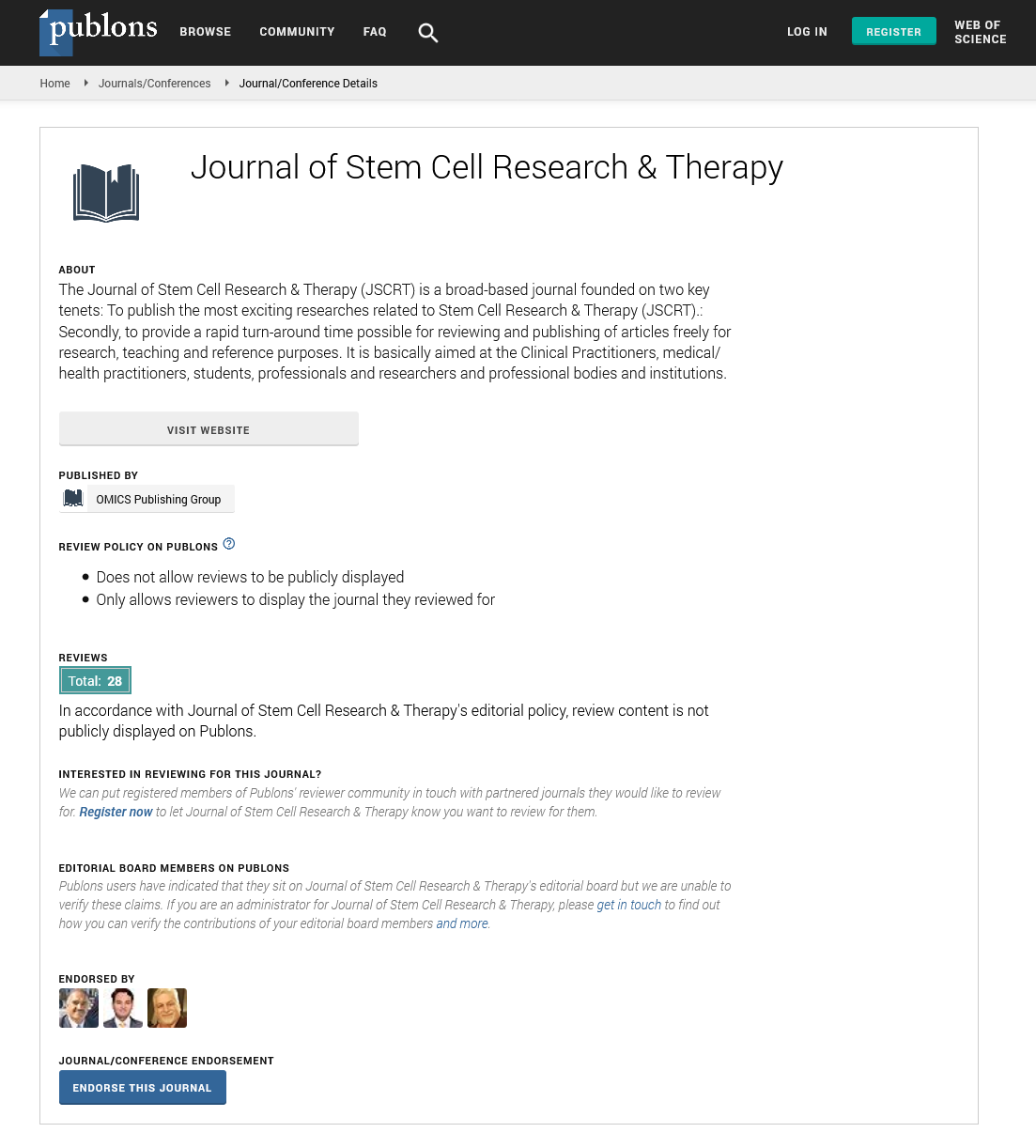Indexed In
- Open J Gate
- Genamics JournalSeek
- Academic Keys
- JournalTOCs
- China National Knowledge Infrastructure (CNKI)
- Ulrich's Periodicals Directory
- RefSeek
- Hamdard University
- EBSCO A-Z
- Directory of Abstract Indexing for Journals
- OCLC- WorldCat
- Publons
- Geneva Foundation for Medical Education and Research
- Euro Pub
- Google Scholar
Useful Links
Share This Page
Journal Flyer

Open Access Journals
- Agri and Aquaculture
- Biochemistry
- Bioinformatics & Systems Biology
- Business & Management
- Chemistry
- Clinical Sciences
- Engineering
- Food & Nutrition
- General Science
- Genetics & Molecular Biology
- Immunology & Microbiology
- Medical Sciences
- Neuroscience & Psychology
- Nursing & Health Care
- Pharmaceutical Sciences
Opinion Article - (2023) Volume 13, Issue 2
Exploring the Potential of Human Embryonic Stem Cells for Diabetes Therapy through Pancreatic Endoderm Differentiation
Jhon Shim*Received: 03-Mar-2023, Manuscript No. JSCRT-23-20422; Editor assigned: 06-Mar-2023, Pre QC No. JSCRT-23-20422(PQ); Reviewed: 21-Mar-2023, QC No. JSCRT-23-20422; Revised: 28-Mar-2023, Manuscript No. JSCRT-23-20422(R); Published: 07-Apr-2023, DOI: 10.35248/2157-7633.23.13.583
Description
There has been evidence suggested that human Embryonic Stem Cells (hESCs) can serve as an endless source of particular adult cell types for use in therapy for degenerative disorders. Few studies have examined the transformation of hESCs into endodermal lineages, particularly into hepatocellular cell types, which may provide an endless supply of insulin-producing cells to treat type 1diabetes. To date, many studies have reported that hESCs could be effectively induced to differentiate into mesodermal and ectodermal bloodlines, such as cardio myocyte endothelial cells, blood cells and nerve cells. Furthermore, despite advances in our understanding of pancreatic development, there is still disagreement over the progenitors of beta cells and the biomarkers that can be used to identify them the discovery of methods for the development of hESCs into pancreas cell types could hold the answer to these concerns because hESCs are a helpful in vitro experiment for lineage tracing. However, the significant failure of hESCs to differentiate into pancreatic tissue suggests that segment consists of hESCs into definitive mesoderm and subsequent involvements toward that pancreatic fate are difficult to accomplish.
It has been demonstrated that mouse and non-human primate ESCs can produce different types of pancreatic cells. Recent research has also revealed that hESCs may be able to develop into cells that produce insulin spontaneously in vitro or via a multi-stage strategy based on these discoveries. However, a number of studies have suggested that the insulin discoloring of ESC-derived molecules is likely caused by apoptotic cells consuming insulin from the culture medium, indicating that more trustworthy analyses should be taken into account from the perspective of beta cell biology and from an endodermal perspective. To date, rather than addressing the kinetics of differentiating from ESCs into pancreatic endoderm, many research using mouse ESCs or human ESCs have concentrated mostly on a rather late phase of differentiation. hESCs are versatile and able to differentiate into many cell types, in contrast to adult body stem cells. Hence, successive decisions on cell destiny resulting from early complex events are a necessary requirement for pancreatic specification. Therefore, it is vital to create an effective method for getting an enriched pancreatic endoderm cell population as a first step in producing functioning islet cell types in this context. In more recent studies, the development of cardiac endodermal cells from hESCs was examined in light of core ideas of early pancreatic specifying under spontaneous differentiation and by applying chemically defined media conditions plus activin A. In the current study, we examined whether efficient pancreatic endoderm creation from hESCs can be achieved by sequentially treating variables that are important for development and employing an in vitro method to produce Embryoid Bodies (EBs). In conclusion, we findings demonstrate that, under specific culture conditions that reflect key ideas of early pancreatic development, differentiating of pancreatic endoderm may be successfully controlled from hESCs. Additionally, according to our research, these cells appear to possess the developmental capacity to differentiate into functionally mature pancreas cell types in vivo. The isolation of induced pluripotent stem cells islet precursors and the in vitro production of significant numbers of matured insulin-producing cells are predicted to be made easier by these discoveries.
Citation: Shim J (2023) Exploring the Potential of Human Embryonic Stem Cells for Diabetes Therapy through Pancreatic Endoderm Differentiation. J Stem Cell Res Ther. 13:583.
Copyright: © 2023 Shim J. This is an open-access article distributed under the terms of the Creative Commons Attribution License, which permits unrestricted use, distribution, and reproduction in any medium, provided the original author and source are credited.

